
views
- Try relaxation techniques like guided imagery, where you picture a calming scene to help your mind decompress. Deep breathing, yoga, and meditation can also help.
- Turn your bedroom into a sanctuary that is ideal for sleep. Keep it dark, cool, and as quiet as possible when it’s time for bed.
- Eat nutritious foods with magnesium and melatonin to help you get sleepy, including dairy, leafy greens, nuts, and seeds.
- Get on a regular sleeping schedule where you wake up and go to bed at the same time every day. Avoid taking naps, as they make it harder to sleep at bedtime.
Relaxation Techniques
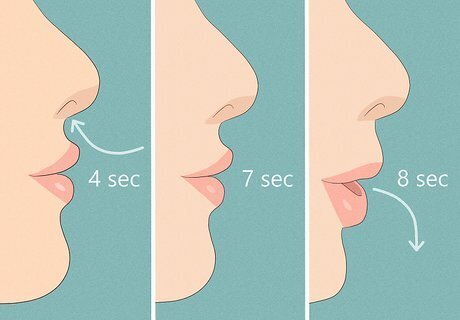
Use the 4-7-8 counting method while taking deep breaths. Counting sheep is a well-known trick, but you can improve on it by taking deep, controlled breaths as you count. Inhale through your nose as you count to 4, hold your breath for about 7 seconds, then open your mouth to exhale for about 8 seconds slowly. Focus only on counting and breathing to clear your mind and slow your heartbeat. Repeat the 4-7-8 method at least 3 more times after that to help your mind and body fully relax.
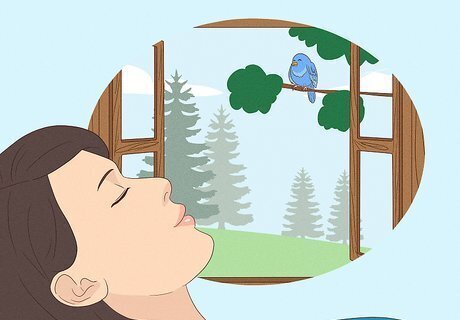
Practice guided imagery and visualize a relaxing scene. Guided imagery is another effective technique you can use to meditate that involves picturing a calming scenario. Think of a place where you feel completely at ease, like a beach or a relaxing place from childhood. Focus only on being there, and imagine it with as many sensory details as possible. Helpful sensory details include sights, smells, and sounds that you feel you might encounter while in this imaginary space. For example, if your scenario was a peaceful, remote cabin in the woods, your sensory details might include the scent of pine trees and the sound of birds calling.
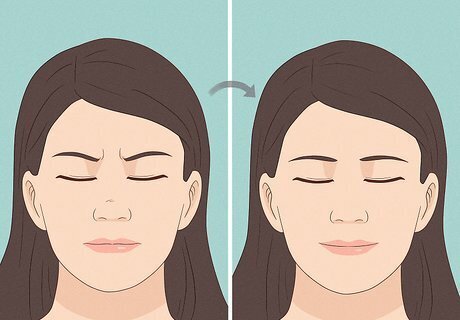
Relax your muscles while using visualization to drift off quickly. This technique is called the military method; first, get into a comfy position and relax the muscles in your face, followed by your shoulders and arms. Then, take deep breaths to release the tension in your chest and relax your muscles through your legs and feet. Once your whole body feels loose, use imagery to visualize a calming scene as you fall asleep. Because members of the military don’t always get a consistent sleep schedule, they created a routine to help them fall asleep anytime. Combining muscle relaxation and imagery can quickly prep your body for sleep!

Try performing progressive muscle relaxation. Start by breathing in and tensing one muscle group, like your toes. Feel them contract, and, as you exhale and release the contraction, imagine your tension flowing away. Continue to contract and relax the muscles in your legs, abs, chest, arms, and head. As you release each muscle, visualize more and more tension leaving your body.
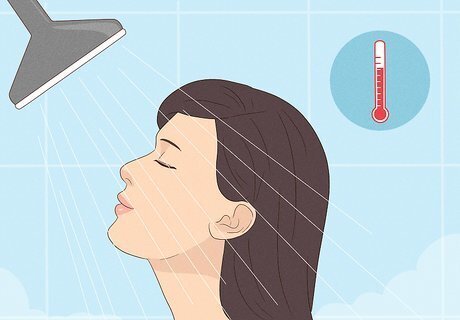
Take a hot soak in the bath or shower. You might find it relaxing to take a bath or shower before bedtime. Plus, going from a hot bath to a cooler bedroom will lower your body temperature, which helps induce sleep. Soak in the water for at least 20 minutes, regardless of whether you take a bath or shower, and do it at least 1 hour before bed to allow your body to cool. Make sure the water is above 100 °F (38 °C) for the best results. Lukewarm water won't provide the same benefits as hot water. A cold bath or shower will cause your body temperature to lower even more drastically, but many people may find cold water uncomfortable.
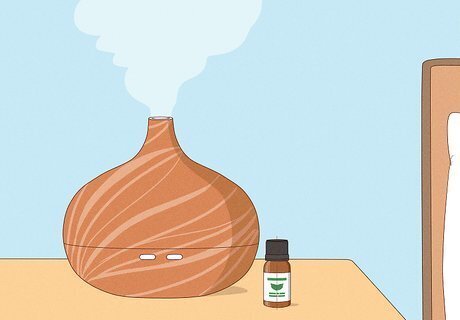
Try aromatherapy to help you relax. Set up an essential oil diffuser in your bedroom so it can infuse the space with a calming scent. Some essential oil has calming properties, so inhaling it before bed will encourage your body to relax and get drowsy. The essential oils most commonly associated with relaxation include lavender, peppermint, and damask rose.
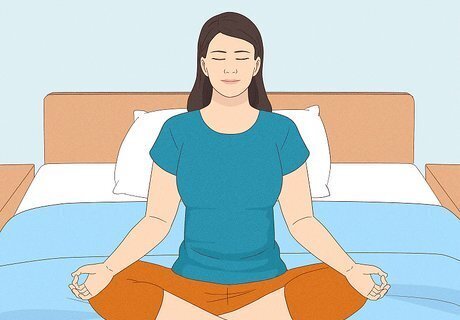
Meditate or do a yoga routine before bed. Meditation can help your body produce more melatonin, which will ultimately help you feel sleepy. Mediate for 3 to 5 minutes at first, then increase that to 15 or 20 minutes over time. However, if meditation isn’t your thing, do yoga instead! Yoga helps your body with stretches and breathing patterns that’ll naturally calm you down before sleep.

Read a book in bed if you can't fall asleep. Staying in bed doing nothing when you're having trouble falling asleep can stress you out and keep you wide awake. If you've tried to doze off for about 20 minutes with no luck, try reading a little. Reading in bed can reduce stress and help your mind to unwind. Remember to pick up a print book, since the light from electronic devices can keep you up. To avoid getting too excited, go for a book you've already read and steer clear of horror or action books.
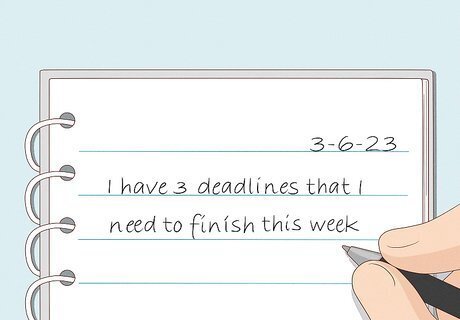
Write in a journal. If you find that your mind won't turn off or you’re struggling with stress from your day, try writing in a journal. Write about the day's events and list things that have been causing you to worry. Getting your worries out of your head and onto paper can help you let go of them and have an easier time falling asleep.
Sleep Environment Adjustments
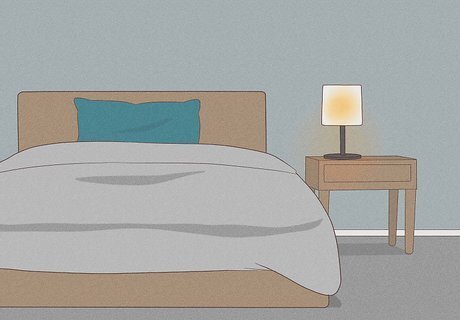
Keep your room dark. Keep lights dim an hour before bedtime, and turn off all overhead lights, night lights, and lamps when you go to bed. Bright light of any kind, including light from an electronic device, can trick your body into thinking it's too early in the day for sleep. If you want to read or write before bed, use a small book light rather than a desktop lamp or overhead light. Blue light keeps you awake, so go for a bulb that gives off a warm glow. Red light bulbs are a great choice. If you have a bright clock, use the dimmer option to lower the brightness of the screen.
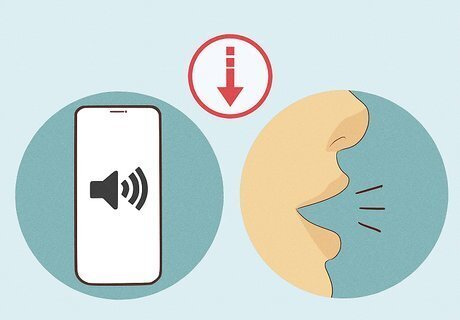
Minimize distracting noises. If you can, keep noise in and around your room to a minimum at night. For example, if you have an old-fashioned clock that ticks loudly and keeps you awake, replace it with a silent one. If you share your home with anyone else, request that they keep noises like talking, music, or TV shows at a low volume while you are trying to sleep.
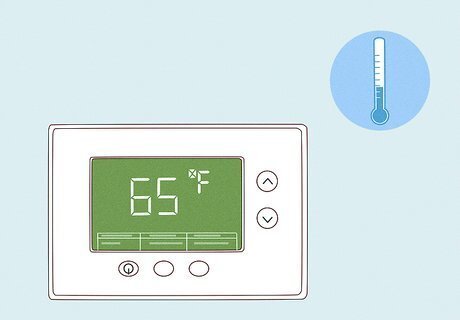
Cool off your room. Lowering your core body temperature helps induce sleep, so try turning down your thermostat. Setting the temperature between 60° and 70° F (15.5°-21° C) could do the trick. Set it low enough that it feels cooler than room temperature, but not so low that you're shivering.
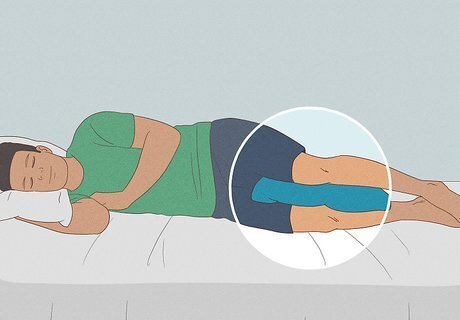
Place a pillow between your knees to keep your body aligned. Ideally, you want to sleep so that your neck is in a straight line with your hips. Try placing a pillow between your knees to keep your hips in a neutral position while you sleep. If necessary, buy new pillows if your current ones aren't keeping you comfortable and aligned. Try to sleep on your back or side. These positions are best for your spine and can offer more restful sleep. Sleeping on your back or spine also keeps your airways open, which can help symptoms of sleep apnea. If sleep apnea is preventing you from getting a full night's sleep, talk to your doctor. They may recommend a sleep study for you to see if you need a CPAP machine.
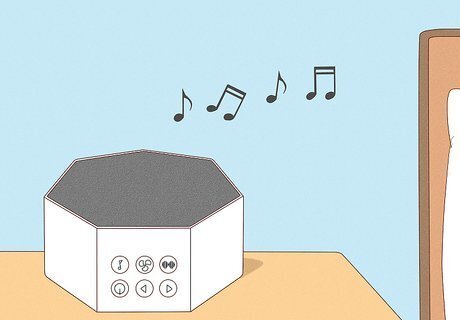
Use a white noise machine. It's tough to fall asleep if you live near a busy road or hear other annoying sounds after bedtime. Get a white noise machine to create a soothing environment in your room, or play recordings of nature sounds, like waves crashing or humpback whales singing. You could also listen to soft, relaxing music, like classical music or contemporary ambient tunes. Try not to fall asleep wearing headphones, since they could slip around and wake you up after you fall asleep. Use a music-playing device with speakers instead.
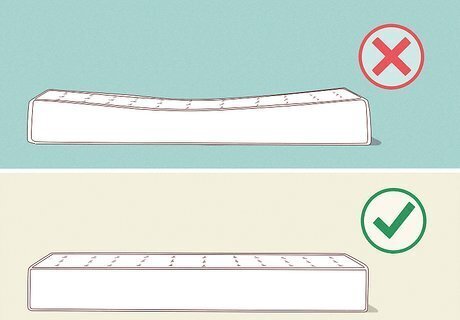
Invest in comfortable bedding to prevent discomfort at night. Uncomfortable surroundings might be keeping you from drifting off to sleep. Even if you can’t afford a brand-new mattress right away, a mattress pad and new sheets can go a long way. If your mattress is too firm or sagging, flip it over or cover it with a foam pad. If you have scratchy or uncomfortable sheets or blankets, get softer ones. Medium-firm mattresses in particular can improve the quality of your sleep. Look for sheets with a high thread count. The higher the thread count, the softer the sheets. A weighted blanket can also help reduce your stress. Make sure all of your pillows are comfortable enough to rest your head on all night. Orthopedic pillows may help with that. If you're on a budget, look online or in outlet stores for high-quality products at affordable prices.
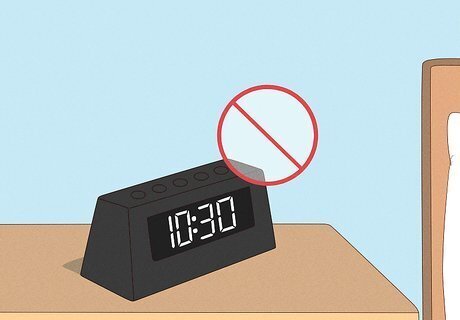
Remove your clock from the bedroom or turn it away from you. Worrying about falling asleep fast can be the very thing that keeps you awake! If your clock is within view and you keep on checking the time, stressing about how late it is, it may prevent you from getting restful sleep. By removing the clock from your bedroom, you’re also removing the urge to keep looking at it. It’s okay if you need your clock for an alarm in the morning. Just move the clock away from you so it’s not easy to reach and turn it away, so the time isn’t visible. The same goes for your phone, if you use that as your alarm clock. Put it face down in a spot that’s ideally beyond arm’s reach for you, so you won’t pick it up and look at it.
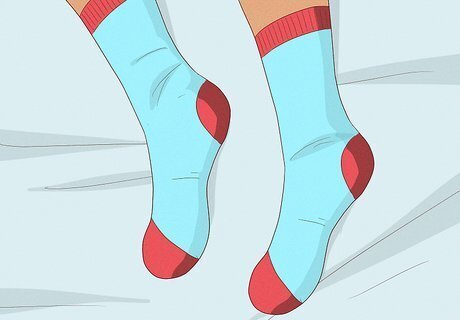
Put on a warm pair of socks if your feet are cold. Silly though it might sound, cold feet can actually prevent you from falling asleep. Less blood can circulate when your feet are cold, which sends your brain a message that it needs to stay awake. Putting on socks can make you feel more comfortable—and, as your feet warm up, it’ll also signal your brain that it’s time for bed.
Diet & Eating Habits

Eat healthy foods that are high in magnesium and calcium. Both magnesium and calcium have been proven to encourage relaxation and sleepiness when you eat them. If you have trouble falling asleep, try introducing more magnesium and calcium-rich foods into your diet, including yogurt, seeds, nuts, and leafy greens. You can also take magnesium supplements, if you prefer. Ask your doctor if magnesium supplements might help you, and be sure to take them with food.
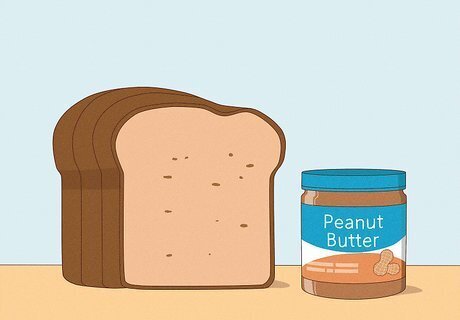
Have a nutritious, whole grain or high-carb snack before bed. Foods that are high in carbohydrates can help you feel warm, sleepy, and comfortable. Having a heavy meal before bed is no good, but you don't want to go to bed hungry, either. If your growling stomach is keeping you up, try a bowl of low-sugar whole grain cereal, whole grain toast with peanut butter, or whole wheat crackers with cheese.
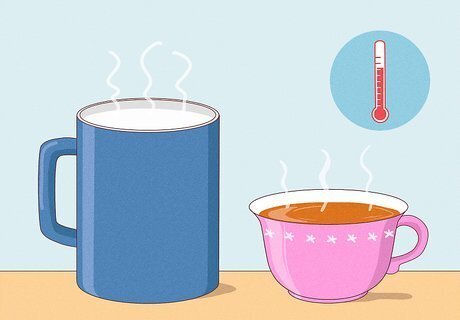
Indulge in a warm drink. Sipping on something warm and calming can relax your body and mind. A cup of warm milk or herbal tea are great options. Herbal teas made from chamomile or lavender—such as chamomile tea—can be particularly effective sleep aids. Avoid anything with caffeine, and don't drink too much of anything at bedtime. Drinking a lot just before bed could cause you to wake up needing a bathroom break. If you have indigestion or heartburn, chamomile tea can also help relieve your symptoms and make sleep easier.

Take a supplement. Like chamomile tea, chamomile supplements could help you doze off faster. You could also try valerian root, one of the oldest herbal remedies recommended for insomnia. Other supplements that may be worth exploring include 5-HTP (an amino acid that can regulate your sleep) and L–theanine (an amino acid with relaxing properties). Talk to your doctor before taking any supplements, especially if you take a prescription medication.

Try melatonin. Melatonin is the hormone responsible for inducing sleepiness when it gets dark outside. Your body naturally produces it, but taking melatonin supplements can help regulate and improve the overall quality of your sleep. Take a small dose of melatonin (usually between .5 and 5 mg) roughly 2 hours before bed to ensure you start feeling drowsy around your bedtime. There isn't much known about long-term use of melatonin supplements, but taking one nightly before bed for less than a month is safe. Melatonin can also be found in bananas, oats, pineapple, oranges, tomatoes, and cherries. As with herbal remedies, consult your doctor before taking melatonin supplements.
Lifestyle Changes
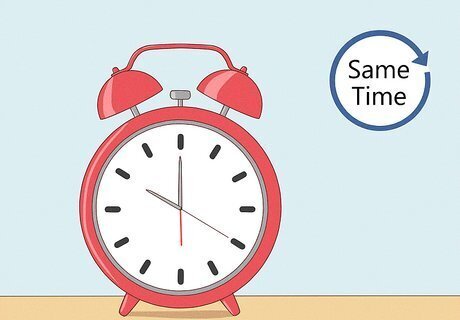
Get on a set sleeping schedule. Going to bed and waking up at the same times every day helps your body to know when it should get tired. Do your best to set a sleep schedule: be in bed by the same time every night and set an alarm for the same time every morning–even on the weekends! Leave enough time for 7 to 9 hours of sleep every night, plus about 45 minutes to wind down before bed. Exposing your body to both sunlight and darkness can help maintain your body’s internal clock. During the day, expose yourself to plenty of natural sunlight or artificial light to stay alert. At night, turn down the lights, as darkness increases feelings of sleepiness.
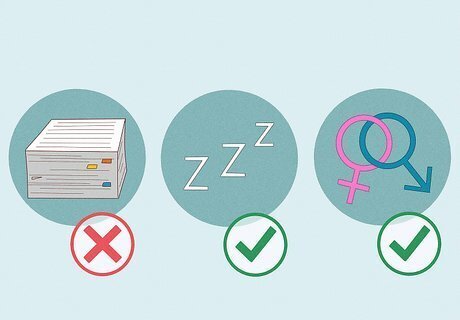
Use your bedroom for sleep, sex, and nothing else. Essentially, treat your bedroom like a relaxing sanctuary and avoid doing work or other activities in your room. If your room becomes a place that is strictly reserved for sleeping, sex, and relaxation, you can help train your mind and body to associate it with a good night's sleep. Since it's a sleeping sanctuary, keep your room tidy and inviting. Keep it clean and smelling fresh, and change your sheets every week or two.
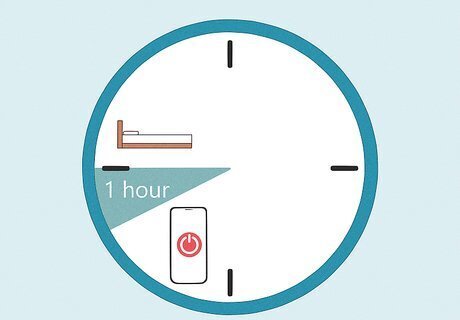
Turn off all electronics an hour before bed. Electronics emit blue light, which suppresses melatonin (a hormone that tells your body to feel drowsy). They also keep your brain engaged and distracted. If you have trouble falling asleep, shut down all electronics with bright screens at least an hour before bed—that includes TVs, laptops, cell phones, and tablets. Browsing social media can also raise your anxiety levels. Say no to Facebook, Twitter, Instagram, email, texting, and any other social media outlet at least an hour before bedtime. If you have to look at a screen before bed, use the lowest possible brightness setting.
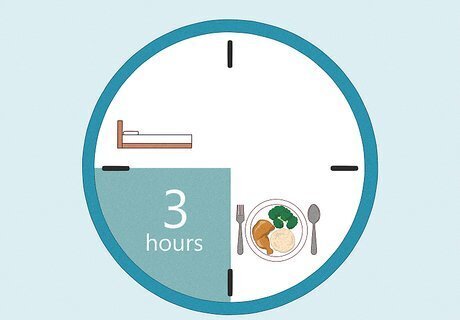
Eat dinner earlier. A heavy meal right before bed can cause a sugar spike, and a digestive system in full gear can keep you from getting comfortable. Try eating dinner at least 3 hours before you go to bed, and avoid spicy foods at dinner time, since these can upset your stomach and raise your body temperature. Some people also experience nightmares or exceptionally vivid dreams after eating spicy foods, which can make it even harder to get a good night’s sleep.
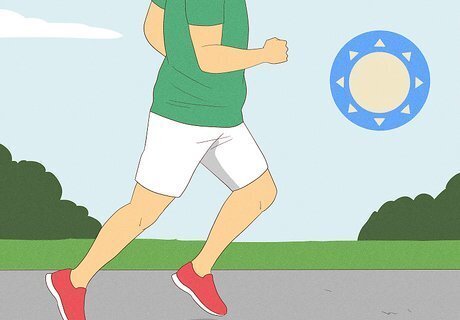
Exercise during the day rather than doing it at night. Avoid working out within 4 hours of heading to bed, as evening workouts can keep you from sleeping soundly. If you have an exercise routine, switch it to the morning—or, at least, as easily in the day as possible. Exercising during the day is great for your sleeping routine, but late-night exercise is disruptive. Working out increases your body temperature, speeds up your heart rate, and stimulates chemicals in your brain that keep you from getting sleepy. This is why exercise is detrimental at night—but also why it’s great for you during the day! Daytime exercise makes it easier to fall asleep when it’s time for bed. If you don’t have an exercise routine, consider starting one.
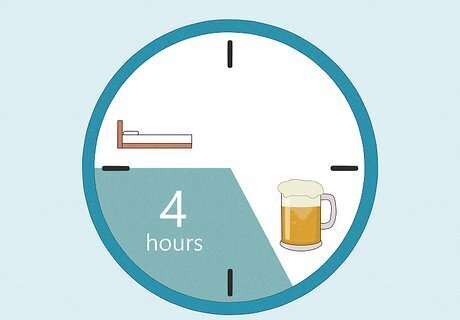
Steer clear of caffeine and alcohol before bedtime. Don't drink caffeine or other stimulants within 6 hours of bedtime, as it can block your body’s production of melatonin and keep you awake. Meanwhile, alcohol does make you drowsy, but it also blocks your body from getting REM sleep, which can ultimately disrupt your natural sleep schedule. Avoid alcohol within 4 hours of bedtime, if possible. If you've cut caffeine in the evenings but still have trouble falling asleep, consider quitting it altogether. It takes time for your body to process both caffeine and alcohol, so drinking them within a few hours of bedtime can still affect you.

Limit yourself to 30-minute naps (or less). When you're totally exhausted, and it's been a long day, the most appealing thing to do is to take a nap. However, naps can alter your sleep cycle and make it harder for you to fall asleep at night. If you absolutely must take a nap, keep it early in the day (so it doesn’t interfere with your bedtime), and make sure you’re only sleeping for about 30 minutes or less.
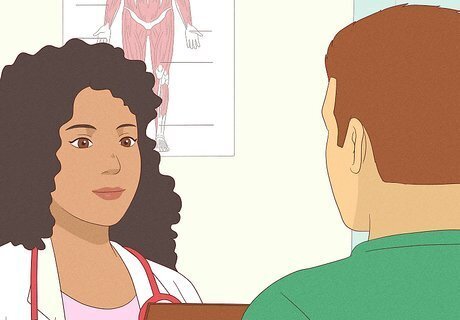
Talk to your doctor if the problem persists. If difficulty falling asleep is interfering with your ability to function or making you depressed, it's time to schedule a doctor's appointment. If you take any medications, ask your doctor if that medicine can interfere with sleep—and, if so, whether there are any alternatives available.















Comments
0 comment